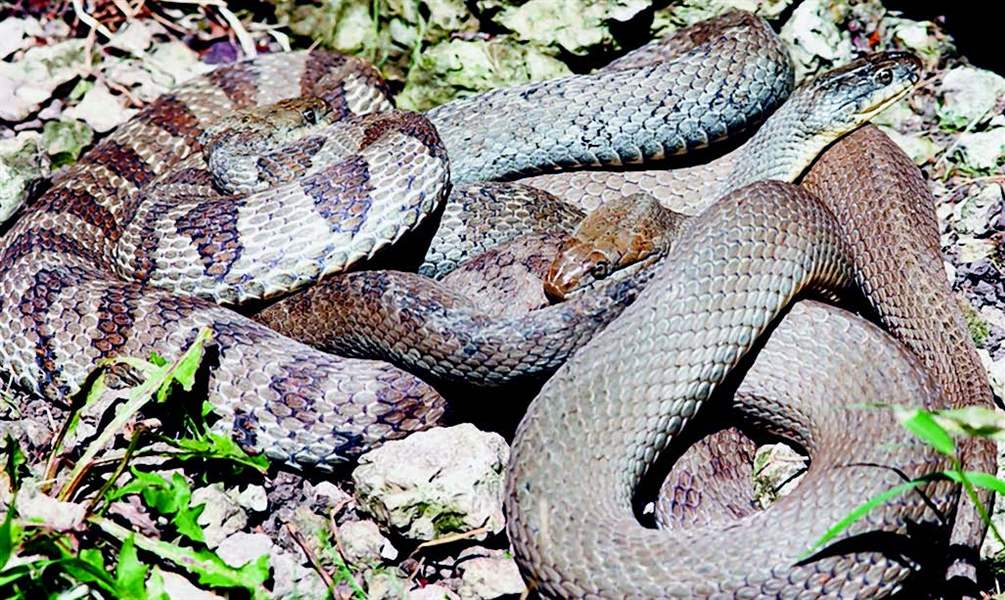
TOLEDO MAGAZINE
Lake Erie Watersnake a subspecies of Northern Watersnake found only on the islands
9/15/2013
The classic Lake Erie Watersnake is solid gray, but many exhibit variations in color and banding, similar to Northern Watersnakes found on the mainland.
THE BLADE/ANDY MORRISON
Buy This Image

The classic Lake Erie Watersnake is solid gray, but many exhibit variations in color and banding, similar to Northern Watersnakes found on the mainland.

The Lake Erie Watersnake can be very aggressive and will readily bite when captured or handled.
The Lake Erie Watersnake in the hands of the Texas native demonstrates its objection to Ms. Mack disrupting its sunbath by first sinking its tiny, needle-like teeth into her forearm. The bite is nonvenomous, but contains an anticoagulant that will cause it to seep for most of the afternoon. The snake also sprays Ms. Mack with its noxious musk, another defense mechanism.
Despite the wound and the stinky blast, Ms. Mack and the other scientists involved in monitoring the recovery of the Lake Erie Watersnake persist. They work daily at saving this snake, which has one of the smallest geographic ranges of any vertebrate on the planet.
PHOTO GALLERY: Click here to see more snake photos
The population had been declining for decades because of habitat loss and eradication efforts by humans and was down to maybe 2,000 animals or less just over a decade ago, according to Kristin Stanford, who came here as a grad student in 2000, stayed, and played the pivotal role in the snake’s strong comeback.
■ 1746: French explorers called the islands “Les Ile aux Serpentes”
or “the Snake Islands.”
■ 1820: Pigs are released on the islands to kill snakes
■ 1960: A campaign of extermination is being waged
■ 1977: Lake Erie Watersnake is listed as endangered in Ontario
■ 1985: Named a candidate species for a protective listing with the
United States Fish & Wildlife Service
■ 1993: ‘Threatened’ status proposed by the USFWS
■ 1999: Listed as ‘Threatened’ by USFWS
■ 2000: Listed as ‘Endangered’ by ODNR
■ 2011: Removed from Endangered Species list
After teetering on the brink of extinction, the snake rebounded, thanks to ambitious research, a better understanding of the snakes and their habitat requirements, and a vigorous outreach program led by Ms. Stanford, “The Island Snake Lady.”
She spoke frequently to school kids here, and they took the message home that despite its often-confrontational disposition, this snake belonged to the islands, and nowhere else.
By August of 2011, the population was strong enough to have the snake removed from the list of federally endangered and threatened species. Lake Erie Watersnake numbers are now estimated at around 12,000.
“And once the snakes started to come back, people were seeing more of them and questioning how they could still be endangered,” Ms. Stanford said. “But in the big picture, they remain pretty rare.”
The Lake Erie Watersnake is a subspecies of the much more prevalent Northern Watersnake, and is believed to have been isolated here when the glaciers melted and water filled the lake. Through natural selection, the Lake Erie Watersnake has developed a skin color that closely matches the dark rocks that dominate the island shorelines where it does its hunting.
The snake Ms. Mack grabbed will be taken to the lab a couple miles away, measured and weighed, and scanned to see if it has previously been tagged with one of the microchips Ms. Stanford uses to track the health of the population. An hour later, Ms. Mack releases the snake at the capture site, where it rejoins a growing population of one of the rarest snakes on Earth.
Contact Blade outdoors editor Matt Markey at: mmarkey@theblade.com or 419-724-6068.